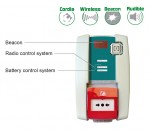£1bn cost of warehouse fires
Published: 24 February, 2014
Research commissioned by the Business Sprinkler Alliance (BSA) and independently conducted by the Centre for Economics and Business Research (Cebr) was released to MPs, chief fire officers and industry bodies at the House of Commons recently. The research is endorsed by Jim Fitzpatrick MP, former fire fighter and secretary of the All Party Parliamentary Group on Fire Safety and Rescue. It was launched alongside the new study from BRE Global, on the cost-effectiveness of installing fire sprinklers in warehouses.
The study looked at the whole-life cost benefit analysis for fire sprinkler installation in three ranges of warehouses sizes. The main findings from the three year study showed that sprinklers are on average a cost effective investment for warehouses with a floor area above 2000 m², with the greatest benefit arising from the reduction in direct fire losses. One in five warehouses in England, approximately 621 premises will have a fire requiring the attendance of fire fighters each year. The total annual cost to the UK economy of fires in English warehouses without fire sprinklers is £232 million.
The report revealed that the British economy had lost 31 billion in GDP and 5,000 full-time jobs through preventable fires in commercial warehouses over the last five years. The cost is equivalent to the annual productivity of the UK’s soft drinks industry.
Cebr looked at the financial and economic impacts of blazes in warehouses without sprinkler systems in England and Wales and found: the fires cause a direct financial loss to business of £230m per year; a loss of £190m per year in productivity and impacts to the supply chain; approximately 1,000 direct and indirect jobs were lost annually through disruption and business failure; 135,000 tonnes of carbon dioxide were released into the atmosphere annually – equivalent to the emissions resulting from the annual domestic electricity consumption by a city the size of Portsmouth; carbon dioxide emission and water used in fire fighting valued at £11 million per year and knock-on effects of each fire include an average of 21 local business impacted by road closures and air and water contamination.
Cebr and the BSA are calling for better education on the substantial benefits that fire sprinklers can deliver to the business community and wider economy. The two organisations are calling for government to review existing building standards to bring policy on fire sprinklers in warehouses in line with competitor economies. For example, in Germany the maximum recommended floor space without fire sprinklers is 1,200 m², this rises to 3000 in France, 5000 in Belgium, 14,000 in Ireland and 20,000 in England.





 ARCO, a leading UK safety company, reports it recently brought Thermo-Man, a life-size thermal burn injury evaluation system, on its first visit to the UK. In a series of educational seminars for customers, held at the Humberside Fire Service’s Headquarters, Hessle and Linlithgow,
ARCO, a leading UK safety company, reports it recently brought Thermo-Man, a life-size thermal burn injury evaluation system, on its first visit to the UK. In a series of educational seminars for customers, held at the Humberside Fire Service’s Headquarters, Hessle and Linlithgow, CORDIA reports its innovations have contributed towards a radical modernisation of the fire-fighting equipment that is available in the market. The company says it is constantly looking to introduce new solutions aimed at improving fire-fighting equipment and is the inventor of the first wireless fire alarm.
CORDIA reports its innovations have contributed towards a radical modernisation of the fire-fighting equipment that is available in the market. The company says it is constantly looking to introduce new solutions aimed at improving fire-fighting equipment and is the inventor of the first wireless fire alarm.
